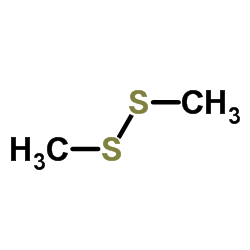Dimethyl disulfide

Dimethyl disulfide structure
|
Common Name | Dimethyl disulfide | ||
|---|---|---|---|---|
| CAS Number | 624-92-0 | Molecular Weight | 94.199 | |
| Density | 1.1±0.1 g/cm3 | Boiling Point | 109.7±0.0 °C at 760 mmHg | |
| Molecular Formula | C2H6S2 | Melting Point | -85 °C | |
| MSDS | Chinese USA | Flash Point | 24.4±0.0 °C | |
| Symbol |



GHS02, GHS06, GHS09 |
Signal Word | Danger | |
|
Olfactometry Profiles and Quantitation of Volatile Sulfur Compounds of Swiss Tilsit Cheeses.
J. Agric. Food Chem. 63 , 7511-21, (2015) To establish the odor profiles of three differently fabricated commercial Swiss Tilsit cheeses, analyses were conducted using headspace solid-phase microextraction gas chromatography-mass spectrometry/pulsed flame photometric detection and gas chromatography-... |
|
|
Quantification of methylated selenium, sulfur, and arsenic in the environment.
PLoS ONE 9(7) , e102906, (2014) Biomethylation and volatilization of trace elements may contribute to their redistribution in the environment. However, quantification of volatile, methylated species in the environment is complicated by a lack of straightforward and field-deployable air samp... |
|
|
Comparison of Aroma-Active Volatiles in Oolong Tea Infusions Using GC-Olfactometry, GC-FPD, and GC-MS.
J. Agric. Food Chem. 63 , 7499-510, (2015) The aroma profile of oolong tea infusions (Dongdingwulong, DDWL; Tieguanyin, TGY; Dahongpao, DHP) were investigated in this study. Gas chromatography-olfactometry (GC-O) with the method of aroma intensity (AI) was employed to investigate the aroma-active comp... |
|
|
Investigation of volatile metabolites during growth of Escherichia coli and Pseudomonas aeruginosa by needle trap-GC-MS.
Anal. Bioanal. Chem 406(26) , 6617-28, (2014) A new method for the growth-dependent headspace analysis of bacterial cultures by needle trap (NT)-gas chromatography-mass spectrometry (GC-MS) was established. NTs were used for the first time as enrichment technique for volatile organic compounds (VOCs) in ... |
|
|
Host-habitat location by the parasitoid, Nasonia vitripennis Walker (Hymenoptera: Pteromalidae).
J. Forensic Sci. 59(1) , 242-9, (2014) This study investigated the role of odorant cues used during host-habitat location by the generalist parasitoid, Nasonia vitripennis Walker. Nasonia vitripennis is a common parasitoid of Dipteran pupae found in association with decaying carrion. Behavioral as... |
|
|
Solid phase microextraction, mass spectrometry and metabolomic approaches for detection of potential urinary cancer biomarkers--a powerful strategy for breast cancer diagnosis.
Talanta 89 , 360-8, (2012) A sensitive assay to identify volatile organic metabolites (VOMs) as biomarkers that can accurately diagnose the onset of breast cancer using non-invasively collected clinical specimens is ideal for early detection. Therefore the aim of this study was to esta... |
|
|
Comparative analysis of bacterial community composition in bulk tank raw milk by culture-dependent and culture-independent methods using the viability dye propidium monoazide.
J. Dairy Sci. 97(11) , 6761-76, (2014) Microbial diversity of 3 raw milk samples after 72 h of storage at 4 °C in a bulk tank was analyzed by culture-dependent and -independent methods. The culture-dependent approach was based on the isolation of bacteria on complex and selective media, chemotaxon... |
|
|
Reactivity of C-terminal cysteines with HNO.
Biochemistry 53(22) , 3689-98, (2014) Nitroxyl (HNO), a potential heart failure therapeutic, is known to target cysteine residues to form sulfinamides and/or disulfides. Because HNO-derived modifications may depend on their local environment, we have investigated the reactivity of HNO with cystei... |
|
|
Effect of processing conditions on the organosulfides of shallot (Allium cepa L. Aggregatum group).
J. Agric. Food Chem. 62(23) , 5296-304, (2014) There is a growing account of the health benefits of H2S as an endogenous cell-signaling molecule. H2S from organic polysulfides, in particular, is increasingly gaining attention for their beneficial effects to cardiovascular health. Here, we studied shallot ... |
|
|
Habitat selection of a parasitoid mediated by volatiles informing on host and intraguild predator densities.
Oecologia 179 , 151-62, (2015) To locate and evaluate host patches before oviposition, parasitoids of herbivorous insects utilize plant volatiles and host-derived cues, but also evaluate predator-derived infochemicals to reduce predation risks. When foraging in host habitats infested with ... |